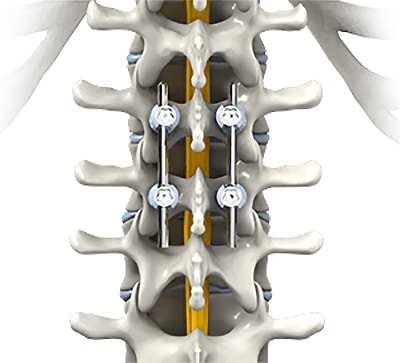Thoracic Spinal Fusion
 Thoracic spinal fusion is a surgery that connects two or more vertebrae (permanently) in your spine. Therefore, eliminating motion between them. This surgery improves the stability or reduces pain due to the following:
Thoracic spinal fusion is a surgery that connects two or more vertebrae (permanently) in your spine. Therefore, eliminating motion between them. This surgery improves the stability or reduces pain due to the following:
- A deformity in the spine. A fusion can help correct a spinal deformity, such as scoliosis.
- Herniated Disc. If a herniated disc needs to be removed, a spinal fusion can help by stabilizing the spine thereafter.
- Weakness or instability in the spine. Sometimes, your spine is unstable if there is abnormal or excessive motion between the vertebrae. This is most commonly seen in people with severe arthritis. A spinal fusion will restore stability in these cases.
Understanding the Spine
The human spine provides body support and allows you to stand upright, bend, and twist. The spinal column has 24 bones called vertebrae. The vertebra is stacked on top of one another. Between two vertebrae, there is a disc of cartilaginous tissue (intervertebral disc.) The intervertebral discs act as shock absorbers and protect the spine from the movement force during activities such as jumping, running, and lifting.
The spine is divided into the cervical, thoracic and lumbar spine. The thoracic spine lies in the mid-back region between the neck and lower back. In fact, it is more rigid due to the presence of ribs. The middle 12 vertebrae make up the thoracic spine.
Thoracic spinal fusion is performed when two or more bones (vertebrae) of the thoracic spine are joined together. Therefore, eliminating the movement between them. This is done by placing bone grafts or bone graft substitutes in between the affected vertebrae. Thus, stimulating healing bones and promotes bone growth. Eventually, it fuses vertebrae into a single solid bone, permanently. Instrumentation such as plates, screws, and rods will hold the vertebrae together while the bone graft heals and fuses them.
Bone Grafts for a Fusion
There are two options for a bone graft. A graft can either be taken from the patient’s own hip bone (autograft,) or a cadaver bone (allograft) through a bone bank. There are several artificial bone grafts to substitute this, such as:
- Demineralized bone matrices (DBMs)
- Bone morphogenetic proteins (BMPs)
- Ceramics
The surgery is performed under general anesthesia. The surgical cut to access the spine is made. The fusion may be made either on the back or front side of the body. However, this depends on the best possible surgical approach for your specific condition. The surgery takes about 3-4 hours. The patient is then discharged within 3 – 4 days after surgery. Pain medications and back braces (or casts) are often used.
The recovery period varies among patients, depending on bone healing ability in each patient. However, a spinal fusion can also be performed through smaller surgical cuts or incisions. This is done by using newer minimally invasive techniques leading to a quicker recovery.
Thoracic Spinal Fusion Indications
Spinal fusion surgery stabilizes the spine. However, there are also additional surgical procedures that can be performed. These surgical procedures include foraminotomy or laminectomy. Which are most commonly used for spinal stenosis or discectomy for degenerative disc disease. Although there are other reasons for this procedure, such a:
- Injury or fracture of the vertebra.
- Instability of the spine caused by an infection, tumor, or spondylolisthesis.
- Correction of abnormal spinal curvature (kyphosis.)
Thoracic Spinal Fusion Risks & Complications
Some specific complications after thoracic spinal surgery include, such as:
- Infection in the spine
- Nerve damage
- Non-union (not enough bone formation) of the vertebrae fused
- Persistent pain at the fusion site
Therefore, by following your doctor’s instructions and maintaining a healthy lifestyle you will achieve better outcomes. If you are searching for a top spinal specialist, call us at 888-409-8006.
